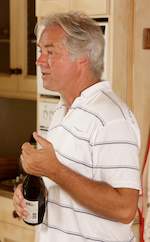Kevin Arnold joined Delheim in 1979 as assistant winemaker, becoming cellarmaster a year later. He was soon dispatched on one of Sperling's 'wine study' trips abroad to learn from the Breuer family of growers in Rüdesheim in the Rheingau.

'Spatz was typically Germanic in his approach: from him, I learned the importance of discipline and structure in a winery; always to look beyond the norm; and that 99 percent was not good enough. But, if I've ever exhibited signs of flair... well, that would have come from California where Spatz gave me the opportunity to realise what we as South African winemakers were up against.'
Kevin was one of the first local winemakers to work at a Californian winery. While a cellar rat at SFW, he had met visiting Tim Mondavi, son of legendary Napa Valley Wineman, the late Robert Mondavi. In 1982, Sperling agreed to send Kevin on a 'student exchange' visit to the headline-grabbing Robert Mondavi Winery in Oakville.
'It was the most incredible experience,' says Kevin, still with some wonder after three decades. 'The great man inspired all of us who worked for him. And I was lucky to be there with some amazing people: Dominique Hébrard [of the family who then owned Saint-Emilion Premier Grand Cru Château Cheval Blanc]: Phil Freese [Mondavi's winegrower and pioneering viticulturist now involved in Cape vineyard Vilafonté]; Zelma Long [Mondavi oenologist later in charge of top Sonoma Valley winery Simi and a partner in Vilafonté]...'
Kevin also experienced the launch of Mondavi's joint venture with Château Mouton Rothschild at the Opus One Winery, home of the Californian cabernet-led Bordeaux-style blend that was to become an international cult red wine.
Inspired, he returned to become one of the 'new wave' winemakers of the 1980s, in the vanguard of innovation, from blanc fume wooded sauvignon blancs, to fermenting wines in oak, to replacing old large vats with new small French oak barrels for maturation.
'I've always enjoyed pushing the envelope, seeing what can be done.'
But it was the creation of Delheim Grand Reserve, originally a cabernet sauvignon that became a blend of classic Bordeaux varieties, which placed the young winemaker at the forefront of red winemaking in the Cape.
He'd realised that red wines were his metier. As had others, including former Springbok rugby player and winemaker Jannie Engelbrecht, who had bought, renovated, and started establishing historic Helderberg wine farm Rust en Vrede Estate as a top red wine producer in the early 1980s.
Engelbrecht asked Kevin to help him with the 1987 vintage, and he took over the winemaking reins the following year. His decade with Rust en Vrede was marked by acclaim, not just locally but internationally, as South African wines gradually started reentering the global wine show arena with the dawn of the 1990s.
While Helderberg reds were and still are often characterised by their so-called New World ‘showiness’ - big fruit, big tannins - Kevin, more influenced in wine style (if not grape variety) by the French than by California, was already chasing elegance.
'Flavour, yes. But I’ve always looked for texture in my wines: that lovely smooth, silky feel on the tongue; no sharp edges from tannin or acidity or excessive wooding.'
 Black mussels with ginger, garlic and chilli recipe with Waterford Sauvignon Blanc by Kevin Arnold....
Black mussels with ginger, garlic and chilli recipe with Waterford Sauvignon Blanc by Kevin Arnold.... Prawn bisque recipe with Waterford Sauvignon Blanc by Kevin Arnold. ...
Prawn bisque recipe with Waterford Sauvignon Blanc by Kevin Arnold. ...